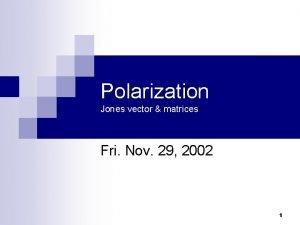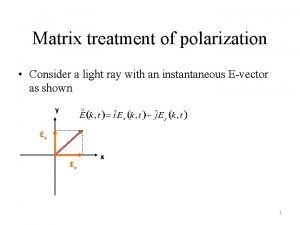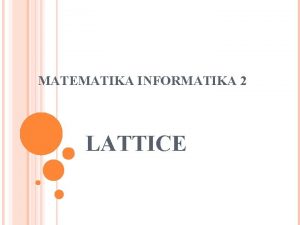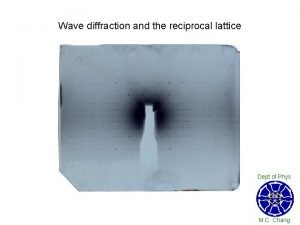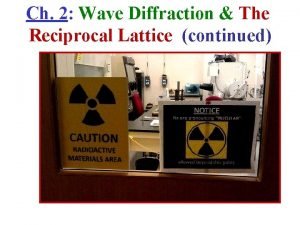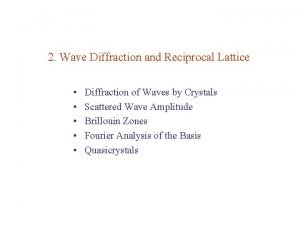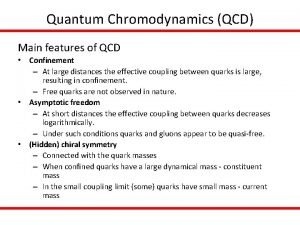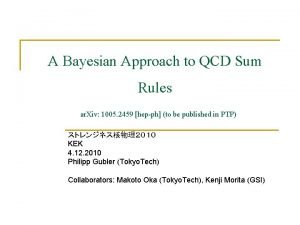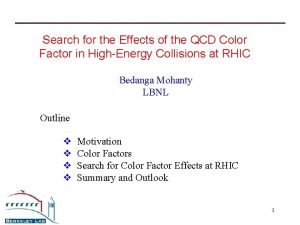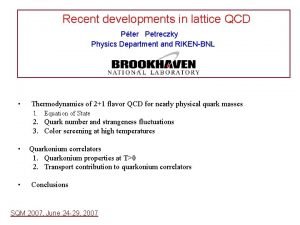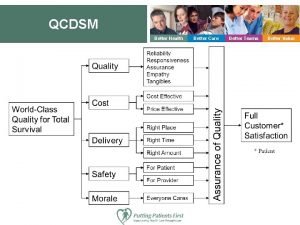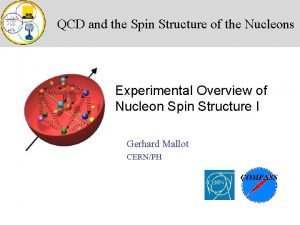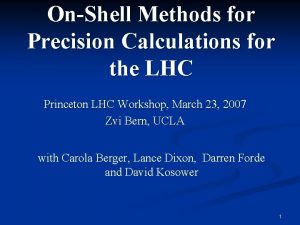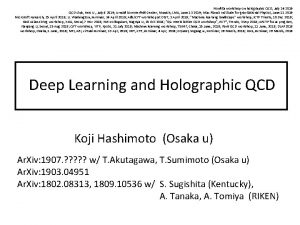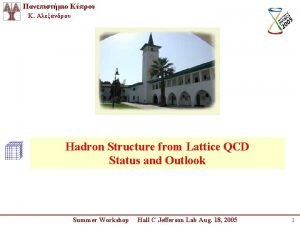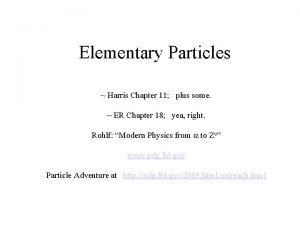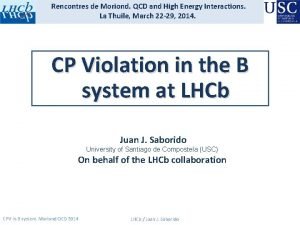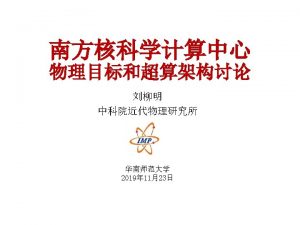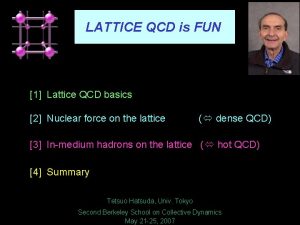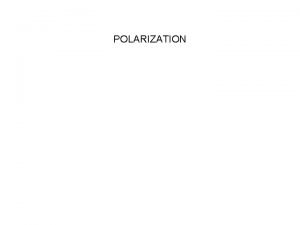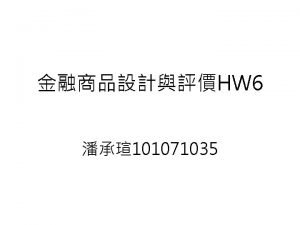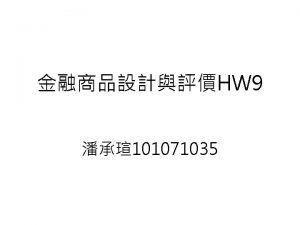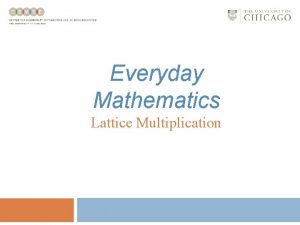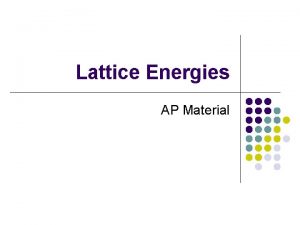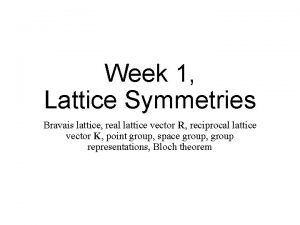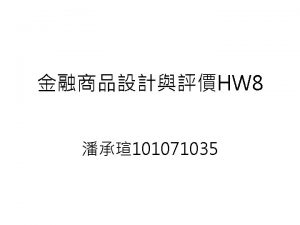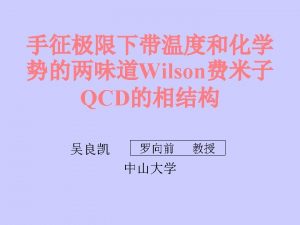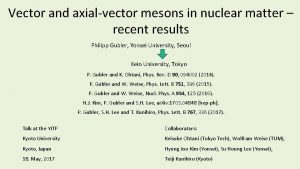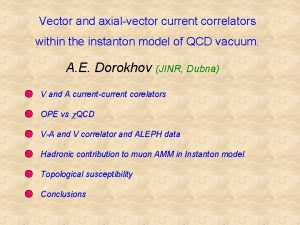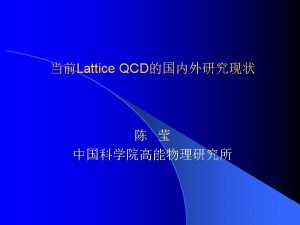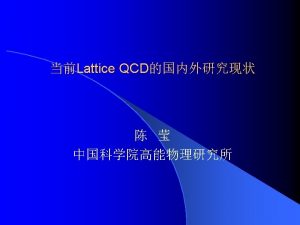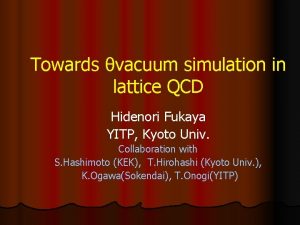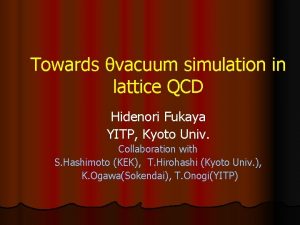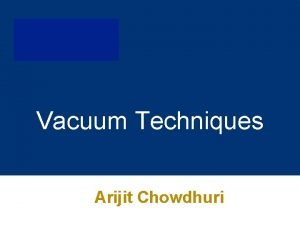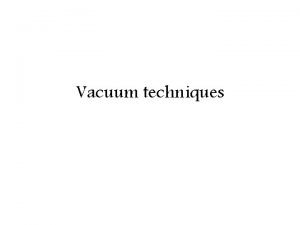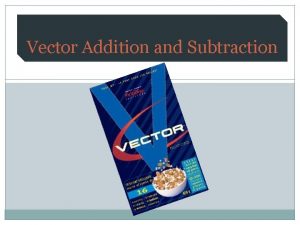Vector and Axialvector Vacuum Polarization in Lattice QCD





![Pion mass difference [Das, et al. (1967)] �Das-Guralnik-Mathur-Low-Young (DGMLY) sum rule �Spectral sum rule, Pion mass difference [Das, et al. (1967)] �Das-Guralnik-Mathur-Low-Young (DGMLY) sum rule �Spectral sum rule,](https://slidetodoc.com/presentation_image_h2/f13bf4344674588ead4dde817645054c/image-6.jpg)
![Models and other lattice works �Low energy constant [DMO (1967)][Ecker (2007)] � Experiment (+ Models and other lattice works �Low energy constant [DMO (1967)][Ecker (2007)] � Experiment (+](https://slidetodoc.com/presentation_image_h2/f13bf4344674588ead4dde817645054c/image-7.jpg)















- Slides: 22

Vector and Axial-vector Vacuum Polarization in Lattice QCD Eigo Shintani (KEK) (JLQCD Collaboration) KEKPH 0712, Dec. 12, 2007

Introduction 2

Target �We try to extract some physical information from vector (V) and axial-vector (A) vacuum polarization at different energy. �Low energy (q 2~mπ2) �Chiral perturbation theory (CHPT) [Peskin, Takeuchi. (1992)] Low energy constant, LEC (L 10) → S-parameter �Muon g-2 Leading hadronic contribution �High energy (q 2 >>mπ2) �Operator product expansion (OPE) chiral <qq>, gluon <GG>, 4 -quark <qΓqqΓq> condensate 3

<VV-AA> �Vacuum polarization of <VV-AA> is associated with spontaneous chiral symmetry breaking. �pion mass diffrence, and L 10 through CHPT and spectral sum rule �<O 1>, <O 8> which are corresponding to electroweak penguin operator �We require non-perturbative method in chiral symmetry. → Lattice QCD using overlap fermion is needed. 4

Vacuum polarization �Vacuum polarization of <JJ> �Current-current correlator: J=V/A Spin 0 Spin 1 vector (pseudo-)scalar in Lorentz inv. , Parity sym. , and �Contribution to ΠJ Low-energy (q 2 ~ mπ2) CHPT, resonance model, … Pion, rho, … meson High-energy (q 2 ≫ mπ2) OPE, perturbation Gluon, quark field 5
![Pion mass difference Das et al 1967 DasGuralnikMathurLowYoung DGMLY sum rule Spectral sum rule Pion mass difference [Das, et al. (1967)] �Das-Guralnik-Mathur-Low-Young (DGMLY) sum rule �Spectral sum rule,](https://slidetodoc.com/presentation_image_h2/f13bf4344674588ead4dde817645054c/image-6.jpg)
Pion mass difference [Das, et al. (1967)] �Das-Guralnik-Mathur-Low-Young (DGMLY) sum rule �Spectral sum rule, providing pion mass difference where ρJ(s)=Im ΠJ(s) We need to know the -q 2= Q 2 dependence of ΠV-A from zero to infinity. �Pion mass difference �One loop photon correction to pion mass �using soft-pion theorem → DGMLY sum rule is correct in the chiral limit 6
![Models and other lattice works Low energy constant DMO 1967Ecker 2007 Experiment Models and other lattice works �Low energy constant [DMO (1967)][Ecker (2007)] � Experiment (+](https://slidetodoc.com/presentation_image_h2/f13bf4344674588ead4dde817645054c/image-7.jpg)
Models and other lattice works �Low energy constant [DMO (1967)][Ecker (2007)] � Experiment (+ Das-Mathur-Okubo sum rule + CHPT(2 -loop)) � 4 -quark condensate � Fit ansatz using τ decay (ALEPH) , factorization method [Cirigliano, et al. (2003)] �Pion mass difference � Experiment � Resonance saturation model (DGMLY sum rule) [Das, et al. (1967)] � Lattice (2 flavor DW) [Blum, et al. (2007)] 7

Our works 8

Lattice parameters gauge action β a-1 fermion action Iwasaki 2. 3 1. 67 Ge. V 2 -flavor overlap m 0 quark mass Qtop ZA = Z V 1. 6 0. 015, 0. 025, 0. 035, 0. 050 0 1. 38 • Vector and axial vector current 9

Extraction of vacuum polarization �Current correlator Additional term, which corresponds to the contact term due to using non-conserving current However, VV-AA is mostly canceled, so that we ignore these terms including higher order. 10

Momentum dependence �Example, mq=0. 015 Q 2ΠV and Q 2ΠA Q 2ΠV-A = Q 2ΠV - Q 2ΠA � Q 2ΠV and Q 2ΠA are very similar. � Signal of Q 2ΠV-A is order of magnitudes smaller, but under good control thanks to exact chiral symmetry. 11

How to extract LECs �One-loop in CHPT In CHPT(2 -flavor), 〈VV-AA〉correlator can be expressed as where LECs corresponds to L 10 in SU(2)×SU(2) CHPT. �DMO sum rule l 5 is a slope at Q 2 =0 in the chiral limit and it can be obtained by chiral extrapolation in the finite Q 2. 12

How to extract LECs (preliminary) CHPT formula at 1 -loop Fitting at smallest Q 2: cf. exp. -0. 00509(57) Except for the smallest Q 2, CHPT at one-loop will not be suitable because momentum is too large. 13

How to extract 4 -quark condensate �OPE for 〈VV-AA〉 At high momentum, one found at renormalization scale μ. a 6 and b 6 has 4 -quark condensate, related to K → ππ matrix element We notice 1. In the mass less limit, ΠV-A starts from O(Q-6) 2. b 6 is subleading order. b 6 / a 6 ~ 0. 03 Our ansatz: linear mass dependence for a 6, and constant for b 6 14

How to extract 4 -quark condensate (preliminary) • Fitting form: Free parameter, a 6, b 6, c 6. • range [0. 9, 1. 3] Result: cf. using ALEPH data (τ decay) a 6 ~ -4. 5× 10 -3 Ge. V 6 15

How to extract Δmπ2 �Two integration range � Q 2 >Λ 2 : � Q 2≦ Λ 2 : fit ansatz, x 1~6 are free parameters, using Weinberg’s spectral sum rule [Weinberg. (1967)] and , 16

How to extract Δmπ2 (preliminary) • Fit range: Q 2≦ 1=Λ 2 • good fitting in all quark masses • In the chiral limit: including OPE result. • smaller than exp. 1260 Me. V 2 about 30~40% Finite size and fixed topology effect ? 17

Summary �Vacuum polarization includes some non-perturbative physics. (e. g. Δmπ2 , LECs, 4 -quark condensate, …) �Their calculation requires the exact chiral symmetry, since the behavior near the chiral limit is important. �Overlap fermion is suitable for this study. �Analysis of ΠV-A is one of the feasible studies with dynamical overlap fermion. �JLQCD collaboration is doing 2+1 full QCD calculation, and it will be available to this study in the future. 18

Backup 19

Low energy scale �CHPT �describing the dynamics of pion at low energy scale in the expansion to O(p 2) �Low energy theory associating with spontaneous chiral symmetry breaking (SχV). �VV-AA vacuum polarization �<VV-AA>=<LR> → corresponding to SχV �important to non-pertubative effect �Low energy constant: NLO lagrangian π L 10 is also related to S-parameter. [Peskin, Takeuchi. (1992)] 20

High energy scale �OPE formula �expansion to some dimensional operators CO : analytic form from pertrubation (3 -loop) <O> : condensate, which is determined non-perturbatively �ΠV-A and one found (in the chiral limit) related to K → ππ matrix element 21

Resonance saturation �Spectral representation �Resonance saturation ΠV-A Non-perturbative effect CHPT OPE Resonance state 22
 Jones vector elliptical polarization
Jones vector elliptical polarization Jones vector elliptical polarization
Jones vector elliptical polarization Suatu poset merupakan lattice jika hanya jika...
Suatu poset merupakan lattice jika hanya jika... Bcc structure factor
Bcc structure factor Reciprocal lattice formula
Reciprocal lattice formula Reciprocal lattice vector
Reciprocal lattice vector Confinement qcd
Confinement qcd Qcd sum rules
Qcd sum rules Color factor qcd
Color factor qcd Qcd
Qcd Qcdmixm
Qcdmixm Qcd lagrangian
Qcd lagrangian Nucleon
Nucleon Qcd penrose
Qcd penrose Qcd
Qcd Qcd
Qcd Qed qcd qfd
Qed qcd qfd Moriond qcd
Moriond qcd Diffraction and polarization
Diffraction and polarization Given that a vector is the directed line segment
Given that a vector is the directed line segment Coordenadas cartesianas
Coordenadas cartesianas Resolution of vectors
Resolution of vectors Vector
Vector
